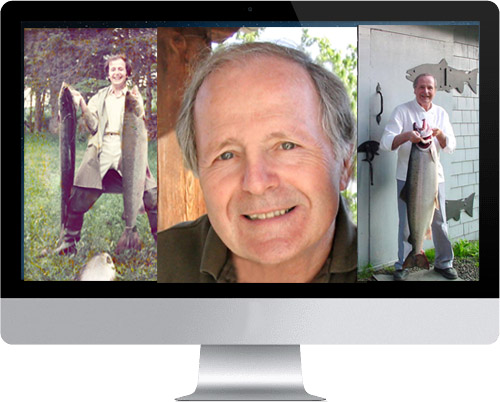
The Salmon ECookbook is your reliable cooking companion as the smartphone or tablet is becoming the ultimate sous-chef in the kitchen. Before you start cooking salmon, here are my recommendations on buying and cooking salmon!
The best part of the salmon is the center cut, so always ask for a center cut filet, or order a whole salmon using one of my unique cooking technique, found in the Ecookbook.
Atlantic salmon is the the most popular salmon and can be smoked using the methods described in the Ecookbook. Consider also King Salmon that has more of a buttery flavor, and Sockeye Salmon with its salmon color and very rich flavor.
Purchase about 4-6 oz of salmon per person.
Baking is one of the easiest, quickest way to cook salmon.
Broiling is an extremely healthy way to cook salmon. Introducing additional fat into the fish by using a little extra virgin olive oil or a pat of butter is an option, but it is not necessary for the success of the dish. Broiled salmon cooks quickly, evenly, and has a simple, delicious flavor.
The benefit of eating farmed salmon versus wild salmon is hotly debated. Some people take the stance that farm-raised salmon is not as nutritious and contains more toxins. However, the differences in farmed versus wild salmon have been blown out of proportion, and in the end, eating either type of salmon is better than none at all. Here's a closer look at how the two types of fish stack up nutritionally.
Omega-3 Fats You may have heard that wild salmon contains higher amounts of omega-3 fats. This just isn’t true. Based on the most recent data in the USDA food database, a three-ounce serving of wild salmon contains 1.4g of long chain omega-3 fats, while the same size serving of farm-raised salmon contains 2g. So if you are eating salmon to get more omega-3 fats in your diet, farm-raised salmon is the way to go.
It takes an average of 6 to 12 minutes to broil a piece of salmon, but this time will change depending on the thickness of the fillet or steak. A larger, thicker salmon portion (8 to 10 ounces) will take longer to cook through than a smaller one (6 ounces) might. A good rule of thumb is that a fillet will take about 6 to 8 minutes to cook per inch of thickness. The FDA recommends cooking all fish to an internal temperature of 145 degrees Fahrenheit.
Measure the salmon fillets at their thickest point. For every 1/2 inch thickness of salmon, place the fish 2 inches from the broiler. So, for a 1-inch thick fillet, place the rack 4 inches from the heat source.
Before pre-heating the oven, place the rack the appropriate distance below the broiler in the top of the oven (in some gas ovens, the broiler is in a drawer below the main oven).
Place the fish, skin side down and rounded pink side up, on lightly greased foil for easy clean-up. If placing the fish directly on a pan, be sure it is oiled or sprayed with nonstick spray.
Drizzle the fish with olive oil and rub it in with two fingers. Sprinkle with herbs (such as dill, thyme, or tarragon) and a little salt and pepper for flavoring.
Place the fish in the oven.
Broil according to the thickness of the fish as outlined above - about 6 minutes per inch of thickness - and check for doneness at this point.
Check the internal temperature of the salmon filets with a digital thermometer. If no thermometer is available, it is possible to check the salmon visually, but it involves sticking a fork into the filets and pulling them apart to check the texture of the fish. It should be flaky if it is done. If appearances don't matter, this is a perfectly acceptable option. If the salmon has to stay pretty, use a thermometer. Start checking the temperature of the salmon 4 to 5 minutes before it is supposed to be done, according to its size. For instance, begin checking a 1-inch thick fillet at about 4 minutes or a 1/2-inch thick fillet at about 2 minutes. The fish will be done when the pink has changed from translucent to opaque with a little golden brown along the top where the element has caramelized the flesh. Remove the fish from the oven and let rest for 3 to 4 minutes.
A perfectly baked piece of salmon is a thing of beauty. But getting there can be tricky. In general, the larger the piece of salmon you are cooking, the longer it will take and vice versa. But what does that really mean?
Length of Time for Cooking Salmon
The amount of time it will take to cook salmon depends on a variety of factors. Use these tips to find the right time for your salmon dish.
For boneless, skinless or skin-on fillets, heat the oven to 400 F. Bake a 2-inch-thick fillet for 18 to 20 minutes or until the desired internal temperature is reached. A 1-inch-thick fillet will be done in 10 to 12 minutes or when the internal temperature is reached.
A bone-in salmon steak should be baked uncovered at 400 F for 10 minutes per inch of thickness or until it reaches the proper temperature.
Bake salmon in a closed packet, whether parchment, foil, or a covered dish, at 350 F. It will cook a bit more quickly so start to check the temperature after 10 minutes and re-cover the fish until the proper temperature is reached.
Check the salmon frequently. Start checking at about 10 minutes and keep checking until the flesh of the fish is just barely an opaque pink and the internal temperature you desire has been reached. Remove the salmon from the oven as soon as the flesh becomes opaque. Serve immediately.
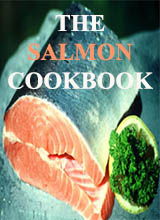
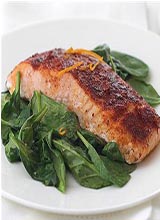
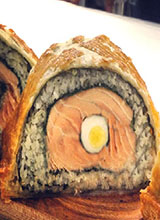
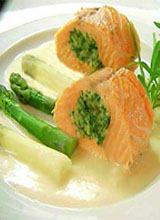
The Salmon Cookbook - Everything You Need to Know + 168 Recipes
Upon purchase, the book is immediately available to download and save to your PC, tablet or smartphone in PDF format (Adobe Acrobat, iBooks).
© 2025 Copyright by The Salmon Cookbook. All Rights Reserved.
